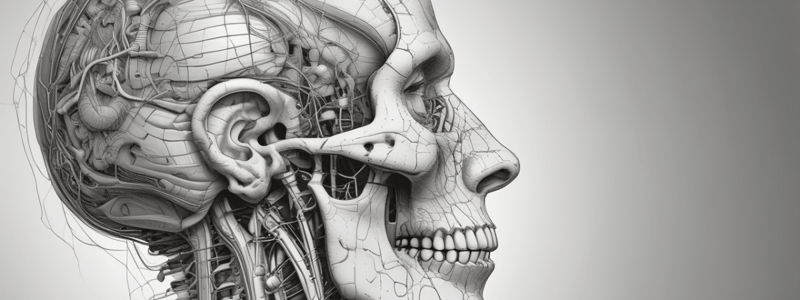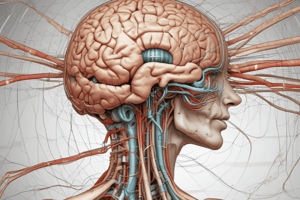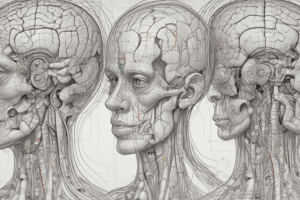Podcast
Questions and Answers
Which tract is responsible for facilitating and enhancing voluntary movement, particularly those related to posture and locomotion?
Which tract is responsible for facilitating and enhancing voluntary movement, particularly those related to posture and locomotion?
- Lateral corticospinal tract
- Medullary reticulospinal tract
- Pontine reticulospinal tract (correct)
- Rubrospinal tract
Which of the following tracts is primarily involved in the sympathetic and parasympathetic outflow?
Which of the following tracts is primarily involved in the sympathetic and parasympathetic outflow?
- Medullary reticulospinal tract
- Rubrospinal tract
- Lateral corticospinal tract
- Hypothalamospinal tract (correct)
Which tract is responsible for carrying sensation of pain, temperature, and crude touch?
Which tract is responsible for carrying sensation of pain, temperature, and crude touch?
- Medullary reticulospinal tract
- Lateral spinothalamic tract (correct)
- Lateral corticospinal tract
- Rubrospinal tract
Which tract coordinates large, gross voluntary movement of the arms and hands?
Which tract coordinates large, gross voluntary movement of the arms and hands?
Which tract is responsible for involuntary movement and reflexes?
Which tract is responsible for involuntary movement and reflexes?
Which tract is responsible for controlling gross movement and maintaining posture?
Which tract is responsible for controlling gross movement and maintaining posture?
Which tract is involved in the precise motor control and skilled movement of hands and fingers?
Which tract is involved in the precise motor control and skilled movement of hands and fingers?
Which of the following tracts originates in the red nucleus?
Which of the following tracts originates in the red nucleus?
Which tract is responsible for regulating muscle tone and facilitating voluntary movement?
Which tract is responsible for regulating muscle tone and facilitating voluntary movement?
Which tract is responsible for transmitting sensation and conscious proprioception, fine touch, two point discrimination, and vibration from the lower and upper limb?
Which tract is responsible for transmitting sensation and conscious proprioception, fine touch, two point discrimination, and vibration from the lower and upper limb?
What is the primary role of the anterior spinocerebellar tract?
What is the primary role of the anterior spinocerebellar tract?
Which tract carries emotional and affective aspects of pain perception?
Which tract carries emotional and affective aspects of pain perception?
What is the posterior spinocerebellar tract primarily responsible for?
What is the posterior spinocerebellar tract primarily responsible for?
Which tracts are located in the anterior white column?
Which tracts are located in the anterior white column?
What is the main difference between the anterior spinocerebellar tract and the posterior spinocerebellar tract?
What is the main difference between the anterior spinocerebellar tract and the posterior spinocerebellar tract?
What is the primary function of the lateral spinothalamic tract?
What is the primary function of the lateral spinothalamic tract?
Which tract is responsible for transmitting proprioceptive information from muscle spindles and Golgi tendon organs?
Which tract is responsible for transmitting proprioceptive information from muscle spindles and Golgi tendon organs?
What is the main difference between the fasciculus gracilis and fasciculus cuneatus?
What is the main difference between the fasciculus gracilis and fasciculus cuneatus?
What is the role of the posterior spinocerebellar tract in the coordination of movements?
What is the role of the posterior spinocerebellar tract in the coordination of movements?
Which tract is responsible for voluntary movement, especially fine and skilled movement of hands and fingers?
Which tract is responsible for voluntary movement, especially fine and skilled movement of hands and fingers?
Which tract plays a crucial role in preception and localization of pain, temperature, and crude touch sensations?
Which tract plays a crucial role in preception and localization of pain, temperature, and crude touch sensations?
What is the primary function of the hypothalamospinal tract?
What is the primary function of the hypothalamospinal tract?
Which tract originates from the primary motor cortex and descends through the internal capsule, cerebral peduncle, and pons?
Which tract originates from the primary motor cortex and descends through the internal capsule, cerebral peduncle, and pons?
Which tract is responsible for influencing involuntary movement and reflexes?
Which tract is responsible for influencing involuntary movement and reflexes?
Which tract is responsible for transmitting sensation of pain, touch, and temperature?
Which tract is responsible for transmitting sensation of pain, touch, and temperature?
What is the primary function of the fasciculus gracilis and fasciculus cuneatus?
What is the primary function of the fasciculus gracilis and fasciculus cuneatus?
Which tract is responsible for aiding in the coordination and modulation of movements involving the upper limb and trunk muscles?
Which tract is responsible for aiding in the coordination and modulation of movements involving the upper limb and trunk muscles?
What type of information does the posterior spinocerebellar tract carry?
What type of information does the posterior spinocerebellar tract carry?
Where is the anterior spinocerebellar tract located?
Where is the anterior spinocerebellar tract located?
Flashcards are hidden until you start studying
Study Notes
Lateral Corticospinal Tract
- Fibers originate from the primary motor cortex and descend through the internal capsule, cerebral peduncle, and pons before crossing over to the opposite side of the brainstem in the medullary pyramids.
- Enables voluntary movement, especially fine and skilled movement of hands and fingers.
- Provides precise motor control and skilled movement.
Anterior Corticospinal Tract
- Innervates axial and girdle muscles.
- Assists in controlling gross movement and maintaining posture.
Rubrospinal Tract
- Originates in the red nucleus.
- Coordinates large, gross voluntary movement of the arms and hands.
- Primarily influences flexor muscles and inhibits extensor muscles.
- Works with other descending motor pathways to modulate muscle tone and facilitate voluntary movement.
Pontine (Medial) Reticulospinal Tract
- Facilitates and enhances voluntary movement, particularly those related to posture and locomotion.
- Works with other motor pathways to regulate muscle tone and balance, and coordinated movement.
Medullary (Lateral) Reticulospinal Tract
- Influences involuntary movement and reflexes.
- Contributes to automatic movements, such as those involved in response to external stimuli.
Hypothalamospinal Tract
- Originates in the hypothalamus.
- Ensures that the body's internal environment remains stable despite changes in external conditions.
- Crucial for involuntary bodily functions, such as heart rate, blood pressure, and respiration.
Lateral Spinothalamic Tract
- Carries sensation of pain, temperature, and crude touch.
- Plays a crucial role in perception and localization of these sensations.
Anterior Spinothalamic Tract
- Carries sensation of pain, touch, and temperature.
- Plays a role in the emotional and affective aspects of pain perception.
Fasciculus Gracilis (Tract of Goll) and Fasciculus Cuneatus (Tract of Burdach)
- Responsible for transmitting sensation and conscious proprioception, fine touch, two-point discrimination, and vibration from the lower and upper limbs.
Posterior Spinocerebellar Tract
- Carries proprioceptive information from muscle spindles and Golgi tendon organs, as well as joint and cutaneous receptors, primarily from the lower limb.
- Helps the cerebellum monitor muscle length, tension, and joint position, contributing to the coordination and adjustment of ongoing movements.
Anterior Spinocerebellar Tract
- Carries proprioceptive information primarily from the upper limb and trunk.
- Aids in the coordination and modulation of movements involving the upper limb and trunk muscles.
Lateral Corticospinal Tract
- Fibers originate from the primary motor cortex and descend through the internal capsule, cerebral peduncle, and pons before crossing over to the opposite side of the brainstem in the medullary pyramids.
- Enables voluntary movement, especially fine and skilled movement of hands and fingers.
- Provides precise motor control and skilled movement.
Anterior Corticospinal Tract
- Innervates axial and girdle muscles.
- Assists in controlling gross movement and maintaining posture.
Rubrospinal Tract
- Originates in the red nucleus.
- Coordinates large, gross voluntary movement of the arms and hands.
- Primarily influences flexor muscles and inhibits extensor muscles.
- Works with other descending motor pathways to modulate muscle tone and facilitate voluntary movement.
Pontine (Medial) Reticulospinal Tract
- Facilitates and enhances voluntary movement, particularly those related to posture and locomotion.
- Works with other motor pathways to regulate muscle tone and balance, and coordinated movement.
Medullary (Lateral) Reticulospinal Tract
- Influences involuntary movement and reflexes.
- Contributes to automatic movements, such as those involved in response to external stimuli.
Hypothalamospinal Tract
- Originates in the hypothalamus.
- Ensures that the body's internal environment remains stable despite changes in external conditions.
- Crucial for involuntary bodily functions, such as heart rate, blood pressure, and respiration.
Lateral Spinothalamic Tract
- Carries sensation of pain, temperature, and crude touch.
- Plays a crucial role in perception and localization of these sensations.
Anterior Spinothalamic Tract
- Carries sensation of pain, touch, and temperature.
- Plays a role in the emotional and affective aspects of pain perception.
Fasciculus Gracilis (Tract of Goll) and Fasciculus Cuneatus (Tract of Burdach)
- Responsible for transmitting sensation and conscious proprioception, fine touch, two-point discrimination, and vibration from the lower and upper limbs.
Posterior Spinocerebellar Tract
- Carries proprioceptive information from muscle spindles and Golgi tendon organs, as well as joint and cutaneous receptors, primarily from the lower limb.
- Helps the cerebellum monitor muscle length, tension, and joint position, contributing to the coordination and adjustment of ongoing movements.
Anterior Spinocerebellar Tract
- Carries proprioceptive information primarily from the upper limb and trunk.
- Aids in the coordination and modulation of movements involving the upper limb and trunk muscles.
Studying That Suits You
Use AI to generate personalized quizzes and flashcards to suit your learning preferences.




